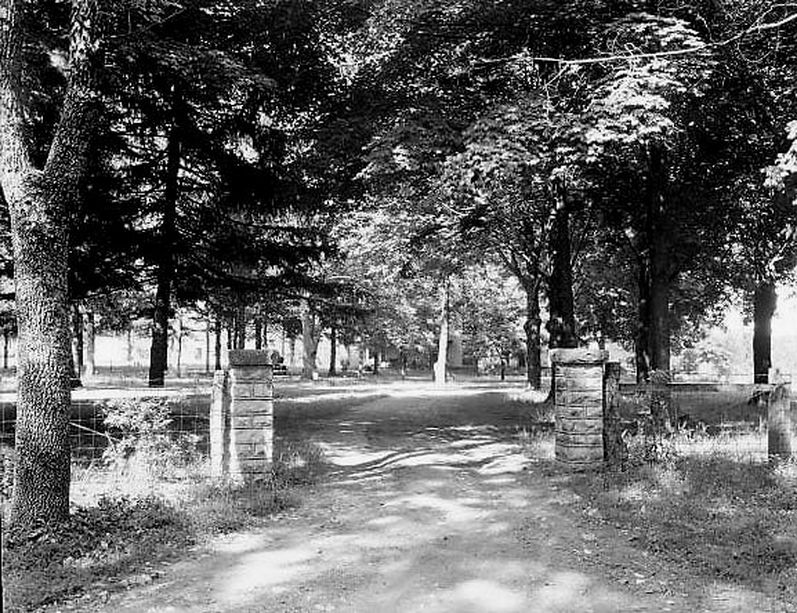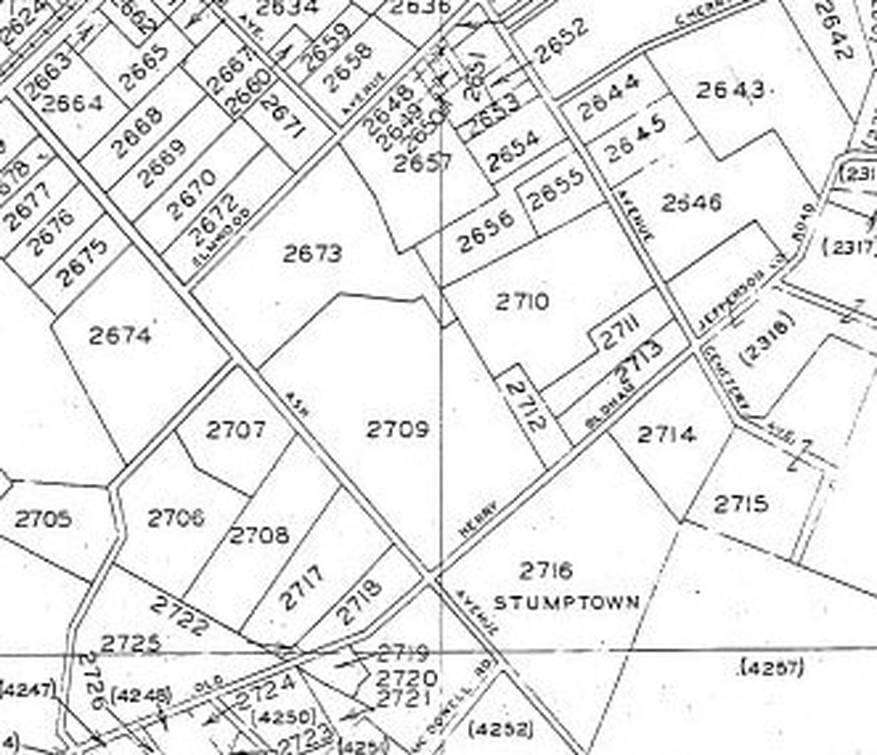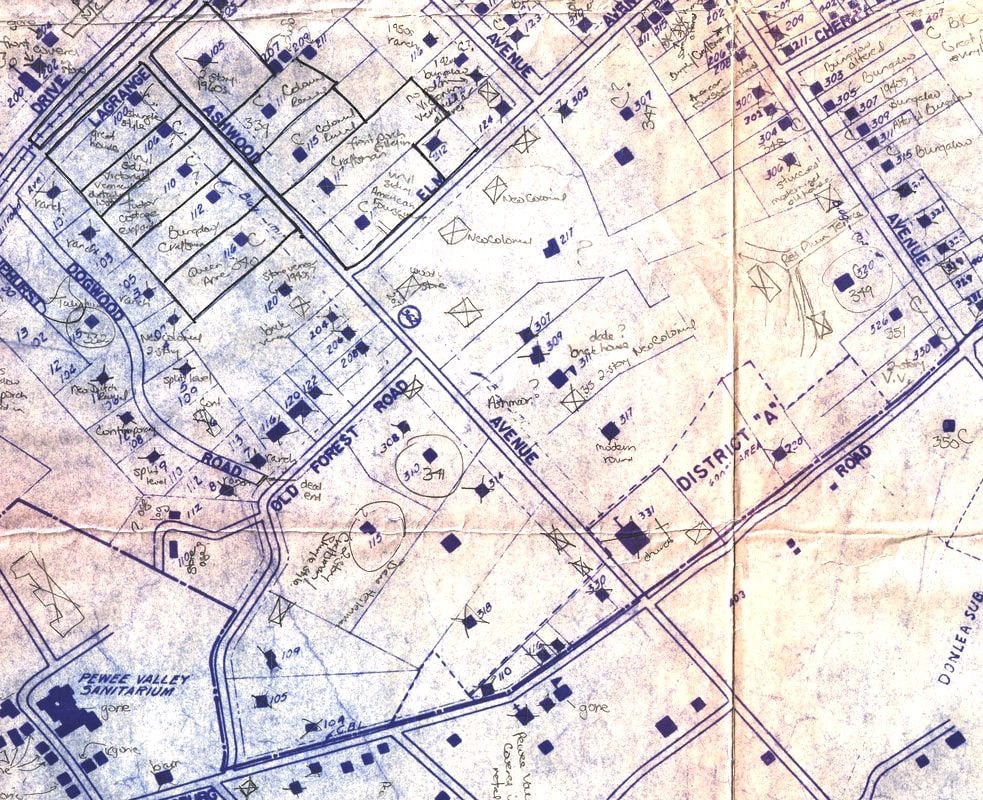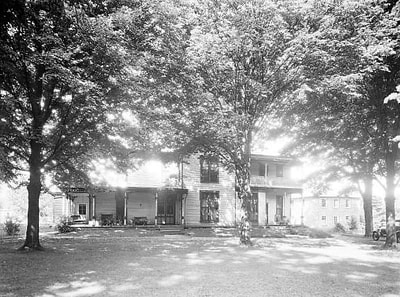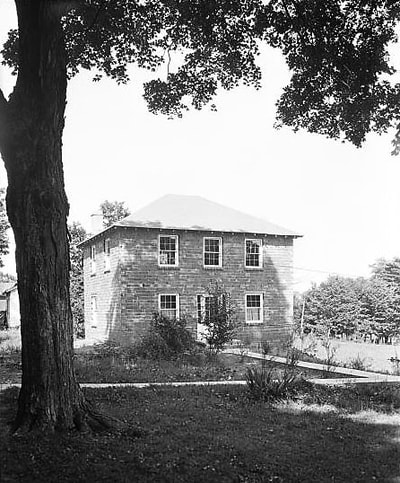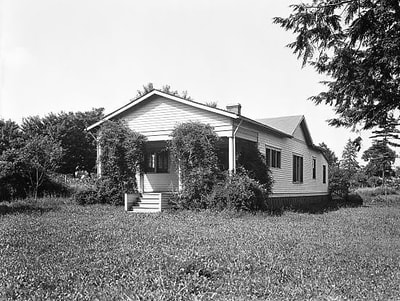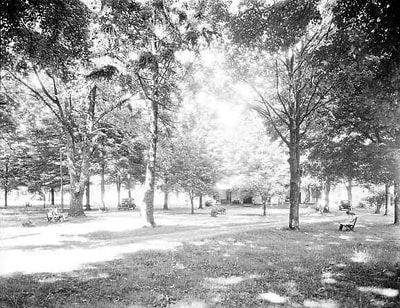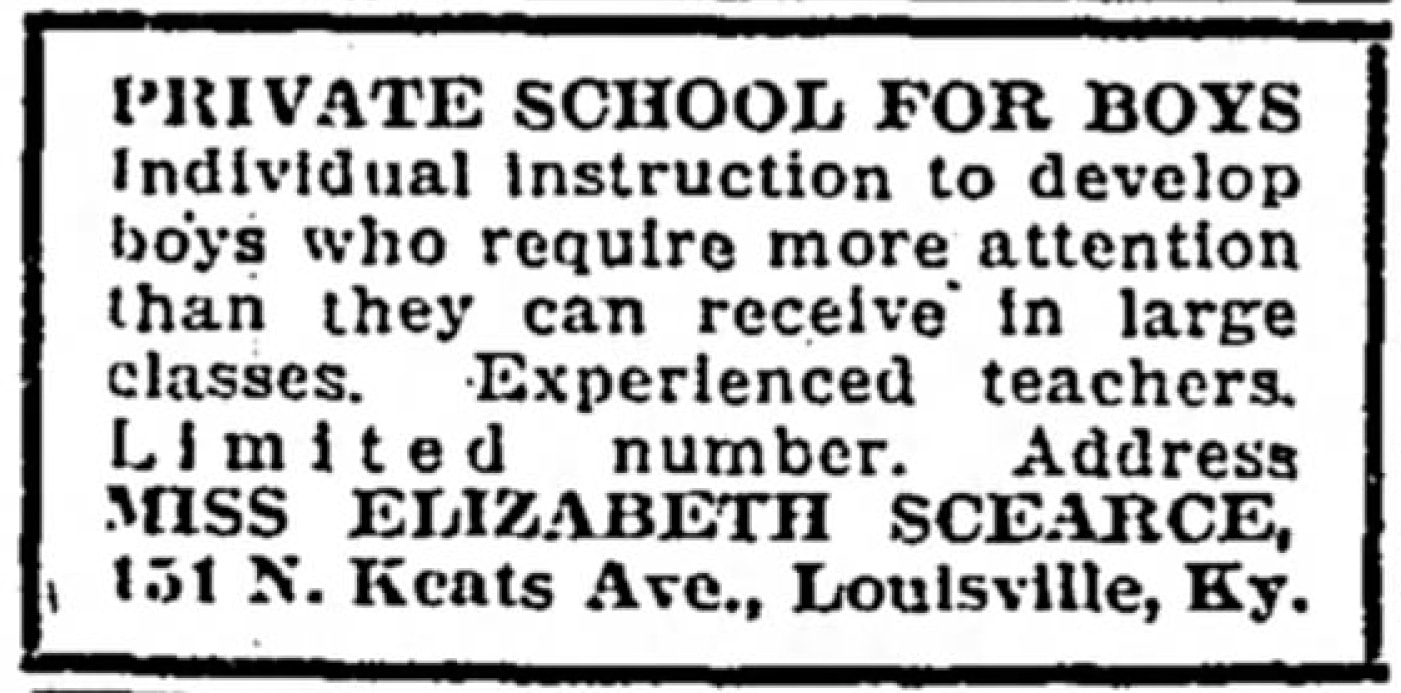Green Haven School & Nursing Home
Green Haven was a private school for adults and children with developmental disabilities that operated in Pewee Valley from as early as 1926 into the 1950s.
The school was located on 26 acres at what is now 309, 311, 315 and 317 Ash Avenue, and the campus included an old frame farmhouse; a new, two-story brick schoolhouse; and another smaller home that may have been built originally for farm labor or domestic servants. On the ca. 1939 WPA Plat Map, the property is labeled Tract 2709.
The school was located on 26 acres at what is now 309, 311, 315 and 317 Ash Avenue, and the campus included an old frame farmhouse; a new, two-story brick schoolhouse; and another smaller home that may have been built originally for farm labor or domestic servants. On the ca. 1939 WPA Plat Map, the property is labeled Tract 2709.
The school was owned and operated by Isaac M. Green and his wife, Elizabeth, according to 1930 and 1940 census data. Census takers referred to the operation as a sanitarium for the "humbleminded" or "feebleminded."
In 1930, the Greens had 16 patients and were caring for them without the benefit of any live-in help. By 1940, with both Elizabeth and Isaac in their early 60s, the school employed a live-in teacher and a live-in nurse, as well as a farm laborer and cook. The 26 patients institutionalized there in 1940 included:
Julian Rosenthal, age 45
Marion Albert, age 39
Helen Hill, age 25
Stanley Goldberg, age 22
Gilberta All, age 21
Susie Pike, age 20
Katherine Hagerty, age 20
Lizzie Berd, age 50
Majorie Butledge, age 25
Anna Pulliam, age 21
Helen Cole, age 18
Catherine Gallager, age 17
Helen Hollowell, age 18
Charles Blanchard, age14
John Adams. age 12
Hubert Petty, age 10
Ray Bryant, age14
Norman Canora, age 17
Vermond Lechleiter, age 14
Wesley Basil, age 17
Billy Huff, age 12
Carol Shaw, age 12
Elsie Littrel, age 10
Mindy McDonald, age 3
Arthur Bodenbender, age 12
Fred Roberts, age 4
Many of them were from Louisville.
In 1930, the Greens had 16 patients and were caring for them without the benefit of any live-in help. By 1940, with both Elizabeth and Isaac in their early 60s, the school employed a live-in teacher and a live-in nurse, as well as a farm laborer and cook. The 26 patients institutionalized there in 1940 included:
Julian Rosenthal, age 45
Marion Albert, age 39
Helen Hill, age 25
Stanley Goldberg, age 22
Gilberta All, age 21
Susie Pike, age 20
Katherine Hagerty, age 20
Lizzie Berd, age 50
Majorie Butledge, age 25
Anna Pulliam, age 21
Helen Cole, age 18
Catherine Gallager, age 17
Helen Hollowell, age 18
Charles Blanchard, age14
John Adams. age 12
Hubert Petty, age 10
Ray Bryant, age14
Norman Canora, age 17
Vermond Lechleiter, age 14
Wesley Basil, age 17
Billy Huff, age 12
Carol Shaw, age 12
Elsie Littrel, age 10
Mindy McDonald, age 3
Arthur Bodenbender, age 12
Fred Roberts, age 4
Many of them were from Louisville.
The school was still in existence in the early 1950s, when Pewee Valley's homes and businesses first received street numbers. It appears on the 1953 District Map as a school at 311 Ash Avenue. Census data for 1950 is not yet available.
The school was still in existence in the early 1950s, when Pewee Valley's homes and businesses first received street numbers. It appears on the 1953 District Map as a school at 311 Ash Avenue. Census data for 1950 is not yet available.
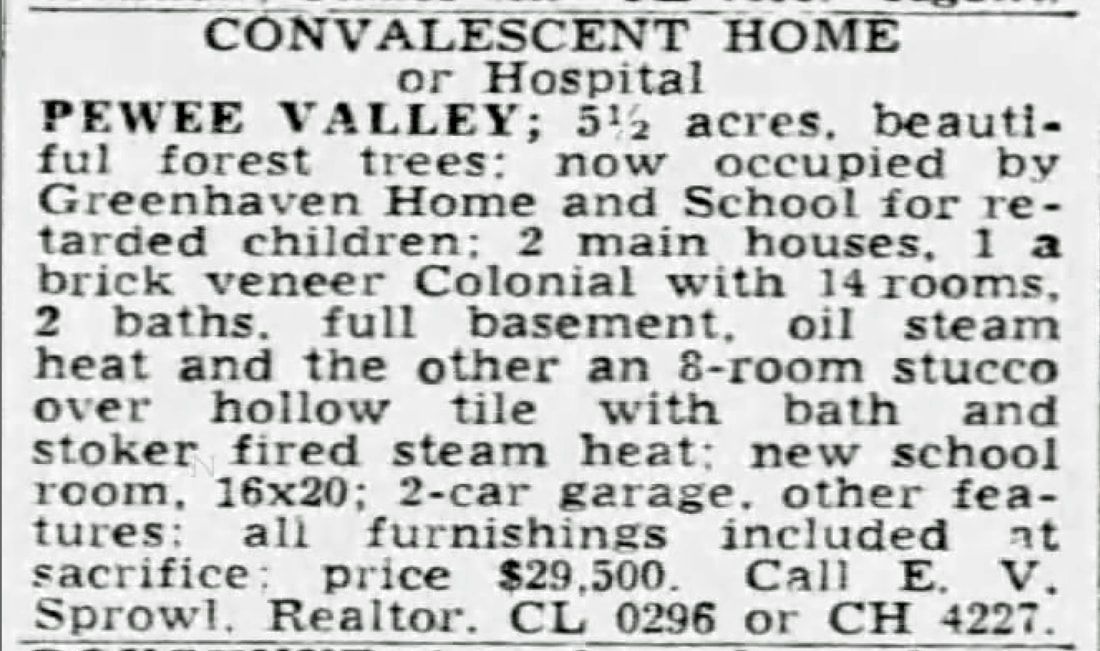
The property went up for sale in 1951. By that time it was reduced to 5.5 acres, according to this classified ad from the January 14, 1951 Courier-Journal:
Green Haven School Photos from the Caufield & Shook Collection, University of Louisville Photographic Archives
About Elizabeth Scearce and Isaac M. Green
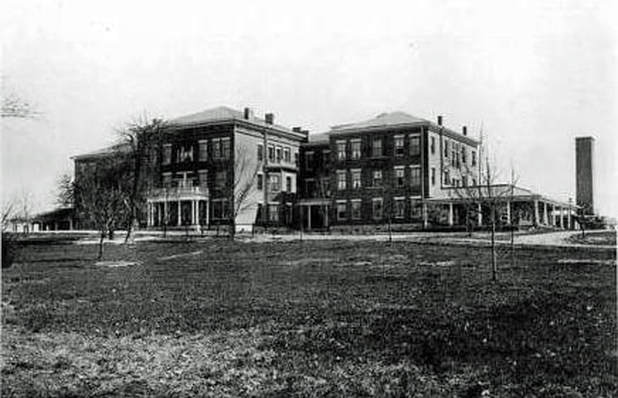 Post card of Kentucky Institution for the Education and Training of Feeble-Minded Children in Frankfort
Post card of Kentucky Institution for the Education and Training of Feeble-Minded Children in Frankfort
Elizabeth Scearce Green was the daughter of George and Mary Taylor Scearce. She was born Catherine Elizabeth Scearce on December 4, 1877, and as a child was nicknamed "Kat." In 1910, she was attending school and living with her family in Lexington, Ky,, where her father ran a retail store.
By 1920, her mother had died and the family had moved to a farm in Bridgeport, Franklin County, Ky. Elizabeth, herself, had finished school and was employed as a secretary at a children's home, most likely the Kentucky Institution for the Education and Training of Feeble-Minded Children in nearby Frankfort.
That institution had originally opened in 1860, when Governor Magoffin signed a bill to create a state-supported facility specifically to educate and train kids with developmental disabilities. The long-term goal was to make them able to contribute to their own upkeep, and the facility offered training in such skills as carpentry, shoe making and sewing. Those requiring long-term custodial care were returned to their home counties.
By the time Elizabeth Scearce was employed at the facility, it was overcrowded -- almost 400 children were enrolled in the school -- and conditions were far from ideal. Elizabeth was a quick study. She recognized there was a market for private institutions for developmentally-challenged children and adults -- those whose families had the means to pay for their care. On September 3, 1922, she ran a classified in the Courier-Journal, advertising a special private school "to develop boys who require more attention than they can receive in large classes."
By 1926, she was married and living in Pewee Valley, according to a story about her father's violent murder in the January 14, 1927 Courier-Journal. George S. Scearce was brutally bludgeoned to death at a small farm he owned in LaGrange just days after visiting his daughter in Pewee Valley:
SKULL OF
FARMER, 81,
IS CRUSHED
_______________
Discovered Dead In
Chair by Neighbor;
Killed Sunday, Is
Belief.
___________________
NO WEAPONS OR
PRINTS FOUND
____________________
Aged Man Living
Alone Is Father of 2
Sons and Daughter
Here
La Grange, Ky., Jan. 13 -- With his skull crushed and blood clotted on his face, collar and coat, the body of George S. Scearce, 81 years old, was found shortly after noon today by G.B. Cranfill, a neighbor, who went to pay a business call to Mr. Scearce's 200-acre farm, a mile north of Buckner, a small town four miles east of here.
Mr. Cranfill, who found the body upright in a chair in the living-room of the house, immediately notified Coroner T.G. Connell. After an investigation, Dr. Connell reported he felt certain tonight that Mr. Scearce had been slain Sunday morning.
The dead man's Bible and Sunday-school book lay on a table at his side. He was clad, save for his coat, in his neatest suit of clothes. One shoe was on and the other lay beside the other foot, leading the coroner to believe Mr. Scearce was slain as he was leaning over to put on the second shoe.
No Clews Found
Dr. Connell said tonight he found no loose dirt in any part of the house that might have fallen from an intruder's shoe. He found no weapons. He found no blood stains. He did not even find a fingerprint. So far as he could determine, no lock in the house had been disturbed, the Coroner said.
Robbery as a motive for the crime was discarded by Dr. Connell and Sheriff Ollie Latimer when the dead man's watch was found in his pocket and $4.16 in another. There was no sign of disorder in the room where the body was found, Dr. Connell reported.
The murderer, Dr. Connell believes, opened a screen door, pushed open the front door, which was unlatched, and crept up behind his victim. The back of the chair in which Mr. Scearce was seated was to the door and six paces from it. He heard no noise, the coroner believes. Four blows, any one of which would have been fatal, were struck. Two bashed in the top of his skull, while two others inflicted gashes on each side of his head.
Three paces in front of the victim, in a corner of the room, stood a double-barreled shotgun. Both barrels were loaded and the weapon was in perfect condition for use...
... Mr. Scearce, a native of Shelby County, enlisted in the Union Army and served throughout the War Between the States. He taught school for several years and served in the Internal Revenue Department. A man of means, he purchased the Oldham County farm many years ago. For five years, he has spent considerable time on it, sometimes alone and sometimes overseeing the work of a tenant farmer.
Between his visits to the farm, Mr. Scearce visited his children in Louisville or Pewee Valley. He spent the Christmas and New Year's holidays with a daughter, Mrs. Isaac Green, Pewee Valley, returning to the farm around January 3 ...
... In addition to his daughter, Mr. Scearce is survived by three other daughters, Mrs. Thomas H. Botts, Bagdad; Mrs. Wood Sumner, 3301 Dumesnil Street, Louisville; and Miss Pauline Scearce, Chicago. Three sons, J.B. Scearce, principal of the Campbellsburg Academy, Campbellsburg; G.G. Scearce, 3231 W. Kentucky Street, Louisville; R.E. Scearce, 827 South Twenth-Eighth Street, Louisville, also survive.
Several months went by before Scearce's killer was apprehended. On March 24, 1927, 24-year-old Walter W. Smith, who lived on a neighboring farm in LaGrange, was arrested and charged with the murder. Poet Robert Frost was right. Good fences do make good neighbors. As do locked doors.
Classified Ads for Green Haven School 1939-1940
Exactly where Elizabeth and her husband were living in Pewee Valley in 1926 is unknown. Any inheritance she received as a result of her father's murder may have helped pay for the land and construction costs for the school on Ash Avenue. We do know for certain that Green Haven School was operating on Ash Avenue in 1929, when Caufield and Shook was hired to photograph the campus.
Also unknown is the date she married Isaac M. Green. Both were single and in their early 40s when the 1920 census was taken. Their marriage had to have taken place between late 1920 and 1926.
Though Peweeans were under the impression "Ike" was a doctor and referred to him as "Doctor Green," he was not. Born in Owen County, Ky. on December 25, 1878, he'd owned and operated a general store on the Stamping Ground Pike in Switzer, Franklin County, Ky., since 1910. Though he probably had plenty of experience dispensing homespun advice to his store's clientele, he had no experience whatsoever with caring for the mentally handicapped. Green Haven was definitely Elizabeth's brainchild.
Meanwhile, conditions at the Elizabeth's former employer, the state-run facility in Frankfort, continued to deteriorate. By the 1930s, the census had almost doubled, exploding to 740. Though the institute was renamed the Kentucky Training Home in 1945, the severely-overcrowded facility was only able to provide custodial care. With its pastoral setting, modern classroom building, and small census, Green Haven School offered a much more attractive and home-like alternative to families that could afford it.
In 1948, Elizabeth was diagnosed with colon cancer, and she made out her last will and testament on January 9 of that year. Thanks to Oldham County Clerk Julie K. Barr for providing the Pewee Valley Historical Society with a copy:
Also unknown is the date she married Isaac M. Green. Both were single and in their early 40s when the 1920 census was taken. Their marriage had to have taken place between late 1920 and 1926.
Though Peweeans were under the impression "Ike" was a doctor and referred to him as "Doctor Green," he was not. Born in Owen County, Ky. on December 25, 1878, he'd owned and operated a general store on the Stamping Ground Pike in Switzer, Franklin County, Ky., since 1910. Though he probably had plenty of experience dispensing homespun advice to his store's clientele, he had no experience whatsoever with caring for the mentally handicapped. Green Haven was definitely Elizabeth's brainchild.
Meanwhile, conditions at the Elizabeth's former employer, the state-run facility in Frankfort, continued to deteriorate. By the 1930s, the census had almost doubled, exploding to 740. Though the institute was renamed the Kentucky Training Home in 1945, the severely-overcrowded facility was only able to provide custodial care. With its pastoral setting, modern classroom building, and small census, Green Haven School offered a much more attractive and home-like alternative to families that could afford it.
In 1948, Elizabeth was diagnosed with colon cancer, and she made out her last will and testament on January 9 of that year. Thanks to Oldham County Clerk Julie K. Barr for providing the Pewee Valley Historical Society with a copy:
I, Elizabeth Green, of Oldham County, Kentucky, being of full age, of sound mind and disposing memory, do make, publish and declare this to be my last will and testament, hereby revoking all will and codicils by me heretofore made. In The Name of God Amen.
|
Item I.
Item II Item III Item IV |
I direct that all my just debts and funeral expenses be paid out of my estate as soon as practicable after the time of my decease.
I give, devise and bequeath one-half (1/2) of my joint owned estate both real and personalty of every kind and description, wheresover situated, which I may own or have the right to dispose of at this time of my decease, absolutely and in fee simple to my Beloved husband, Isaac Green. I give, devise and bequeath the remaining one-half (1/2) of my joint owned estate real and personalty of every kind and description, wheresoever situated, which I may own or have the right to dispose of at the time of my decease, absolutely and in fee simple in equal shares to my brothers, namely James Boyd Scearce, George Gwin Scearce, and Robert Emmett Scearce, and my sisters, namely Rosalie Pauline Lynch, Mary Thomas Botts, and Sarah Scearce Summer. Should any of my brothers and sister pre-decease me without leaving issue living at my decease then the share that would have received shall be divided equally among my brothers and sisters living at my decease and the issue of the others who predecease me. I hereby nominate and appoint my brother, Robert Emmett Scearce, and my sister Sarah Scearce Summer, co-executors of this will, but for any reason one of them would fail to qualify or should be removed, resign or otherwise disqualified from acting as my executor, I hereby authorize and empower my executors or executor or executrix as might be, to compound, compromise, settle and adjust all debts and claims which may be presented against my estate, or which may be due my estate; and to sett at private or public sale, at such prices and upon such terms or credit or otherwise, as they, or he or she, may deem best, the whole or any part of my real estate or personal property, and to execute, acknowledge and deliver deeds and other proper instruments of conveyance therefore to the purchaser or purchasers. My executors or executor or executrix shall act without bond. In Witness whereof I have hereunto signed my name this 9 day of January 1948 Elizabeth Green |
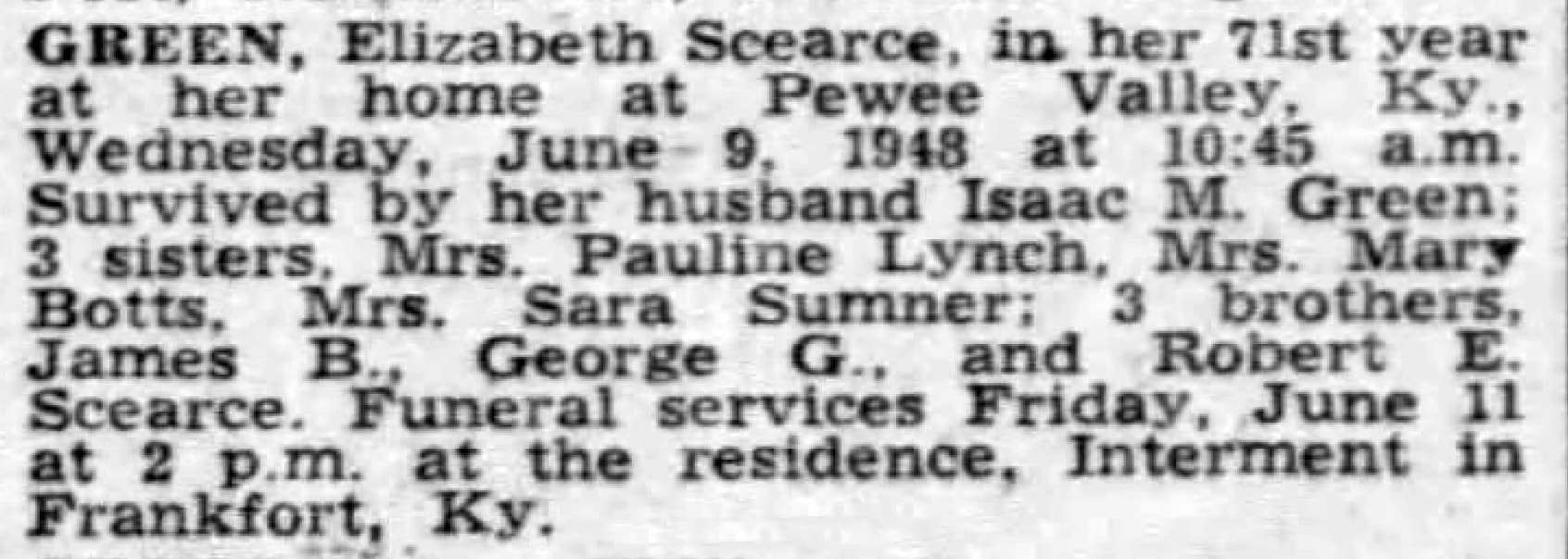
Elizabeth died six months later on June 9, 1948. Her obituary ran in the next day's Courier-Journal:
Though her husband continued to operate Green Haven for a few years after her death, he eventually closed it down and went back to his roots in Franklin County. He died at age 83 on January 5, 1962 on a Frankfort, Ky., farm he'd been living on for two years. He, too, is buried in Frankfort Cemetery.
Though her husband continued to operate Green Haven for a few years after her death, he eventually closed it down and went back to his roots in Franklin County. He died at age 83 on January 5, 1962 on a Frankfort, Ky., farm he'd been living on for two years. He, too, is buried in Frankfort Cemetery.
Long-time Pewee Valley resident Suzanne Schimpeler has pleasant memories of "Doctor" Green:
When I was a child, Dr Green, a psychiatrist, lived there and had his patients living in housing on site. He was a very nice man and kept his patients on the premises. For some reason my parents knew him and liked him.
Dad brought a four-door Mercedes from him. It was a very nice car. When I went to Emory University, it became my car. I loved it as you can well imagine.
When I was a child, Dr Green, a psychiatrist, lived there and had his patients living in housing on site. He was a very nice man and kept his patients on the premises. For some reason my parents knew him and liked him.
Dad brought a four-door Mercedes from him. It was a very nice car. When I went to Emory University, it became my car. I loved it as you can well imagine.

